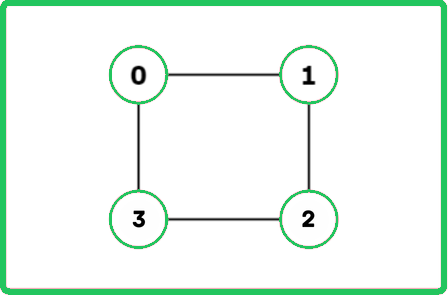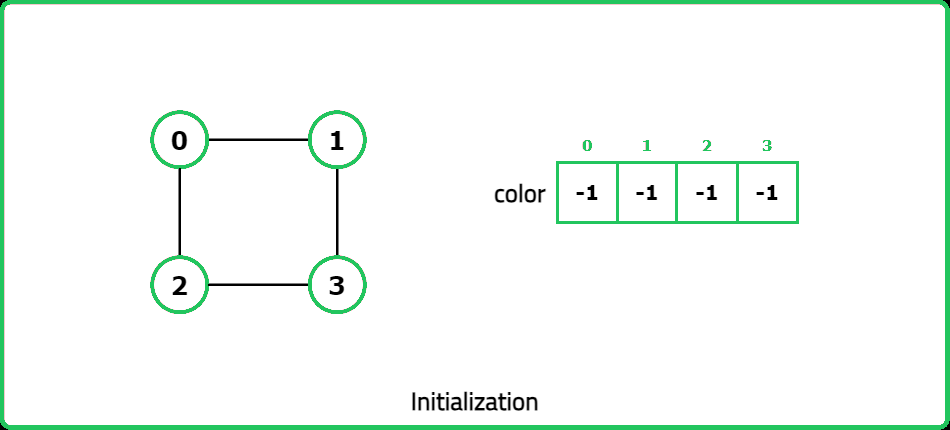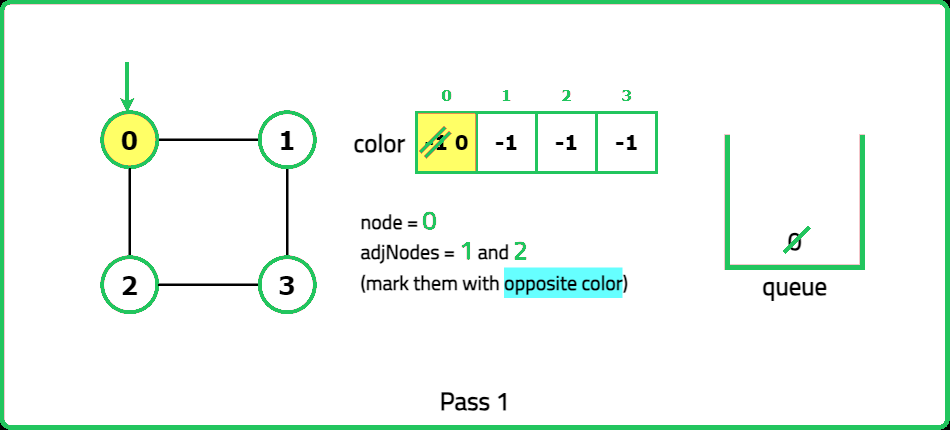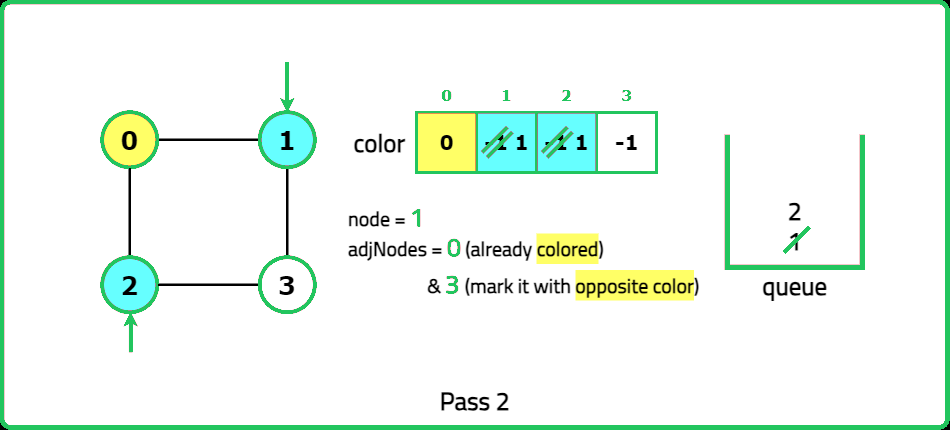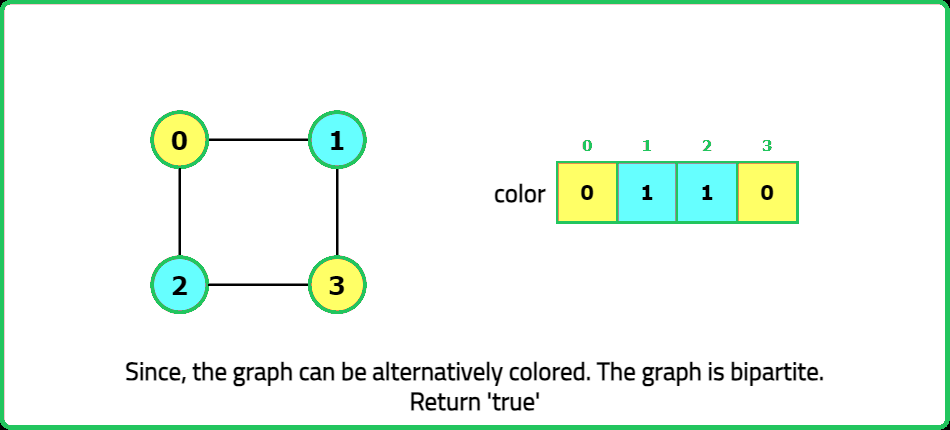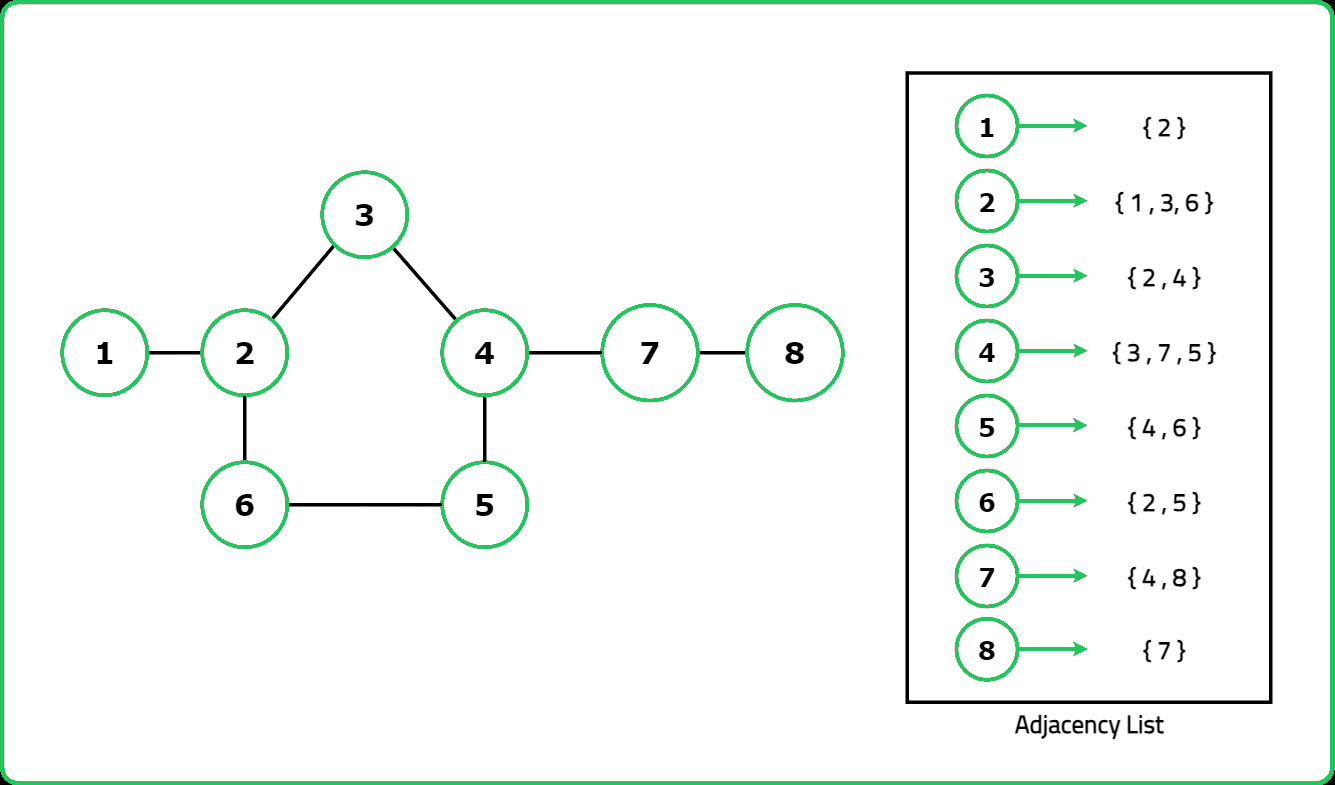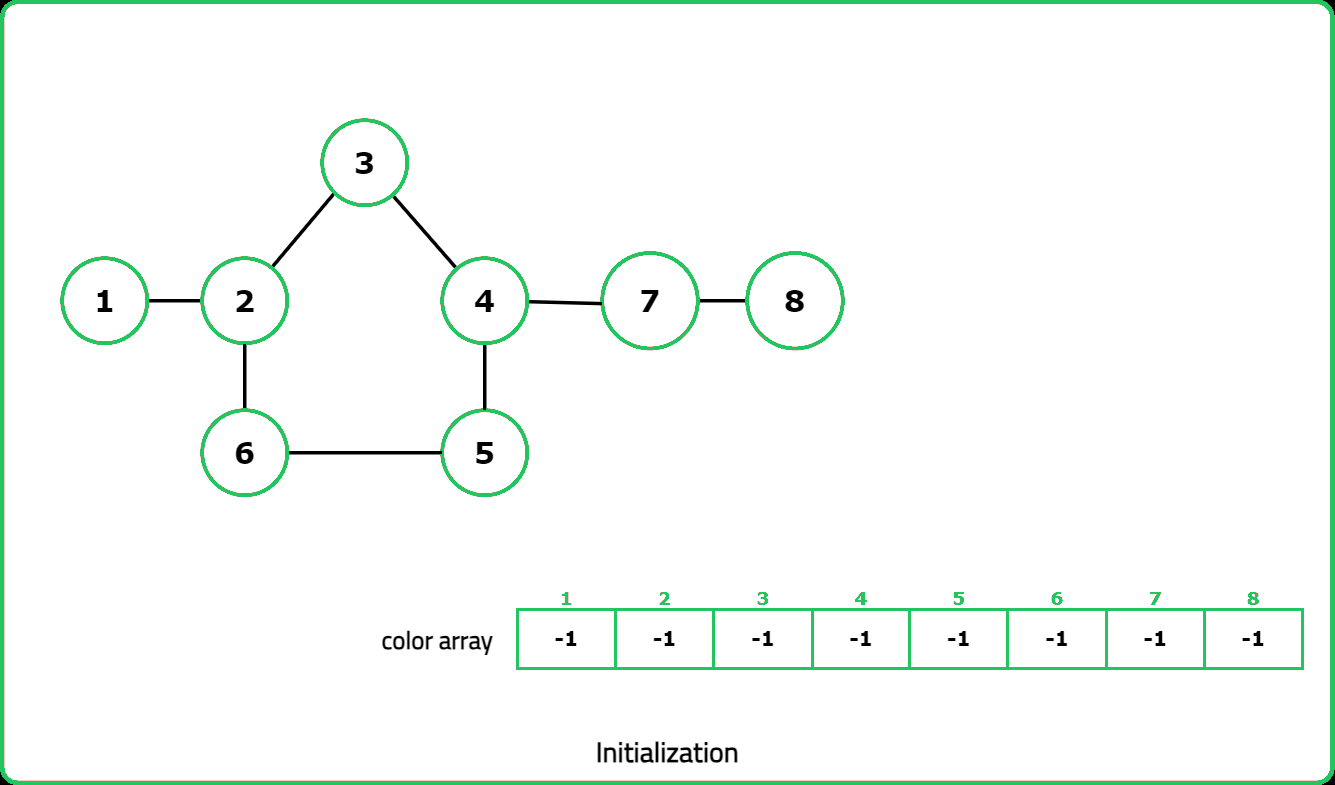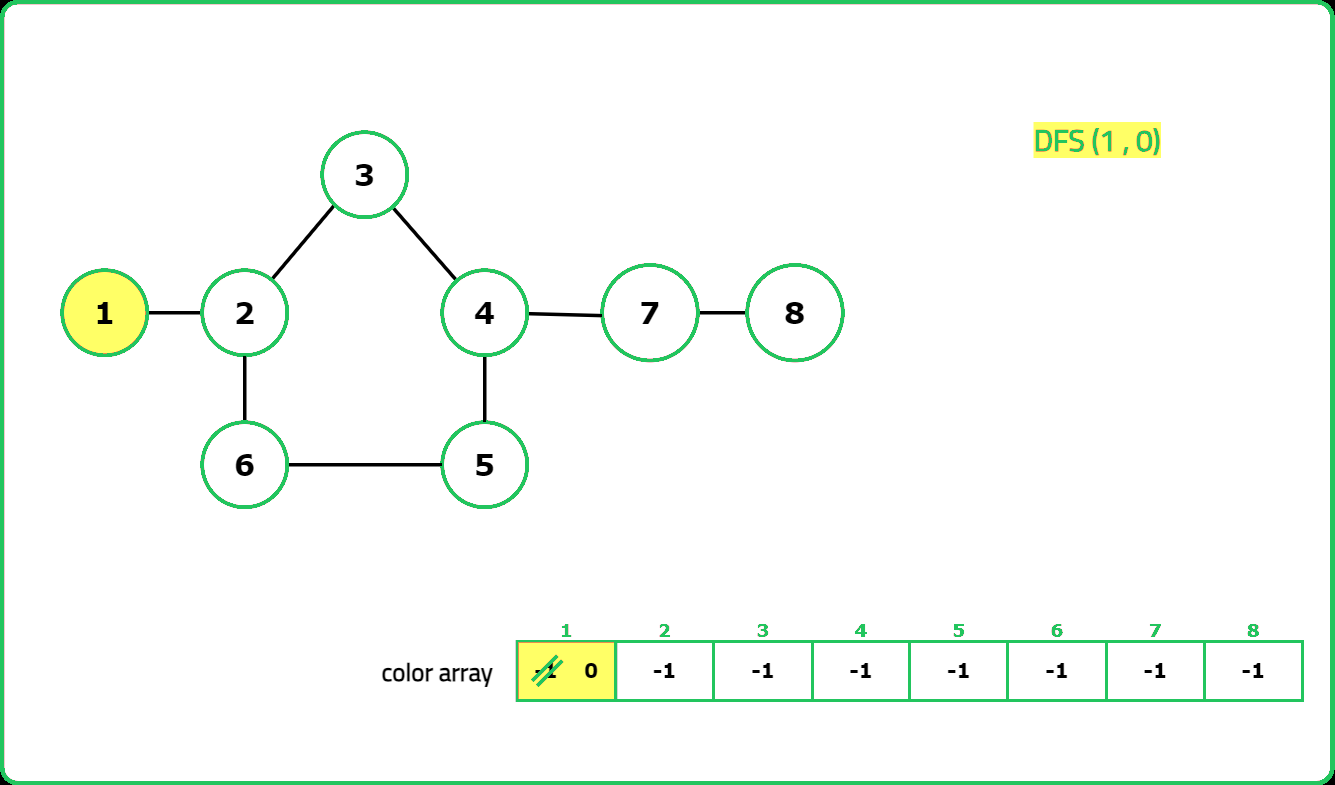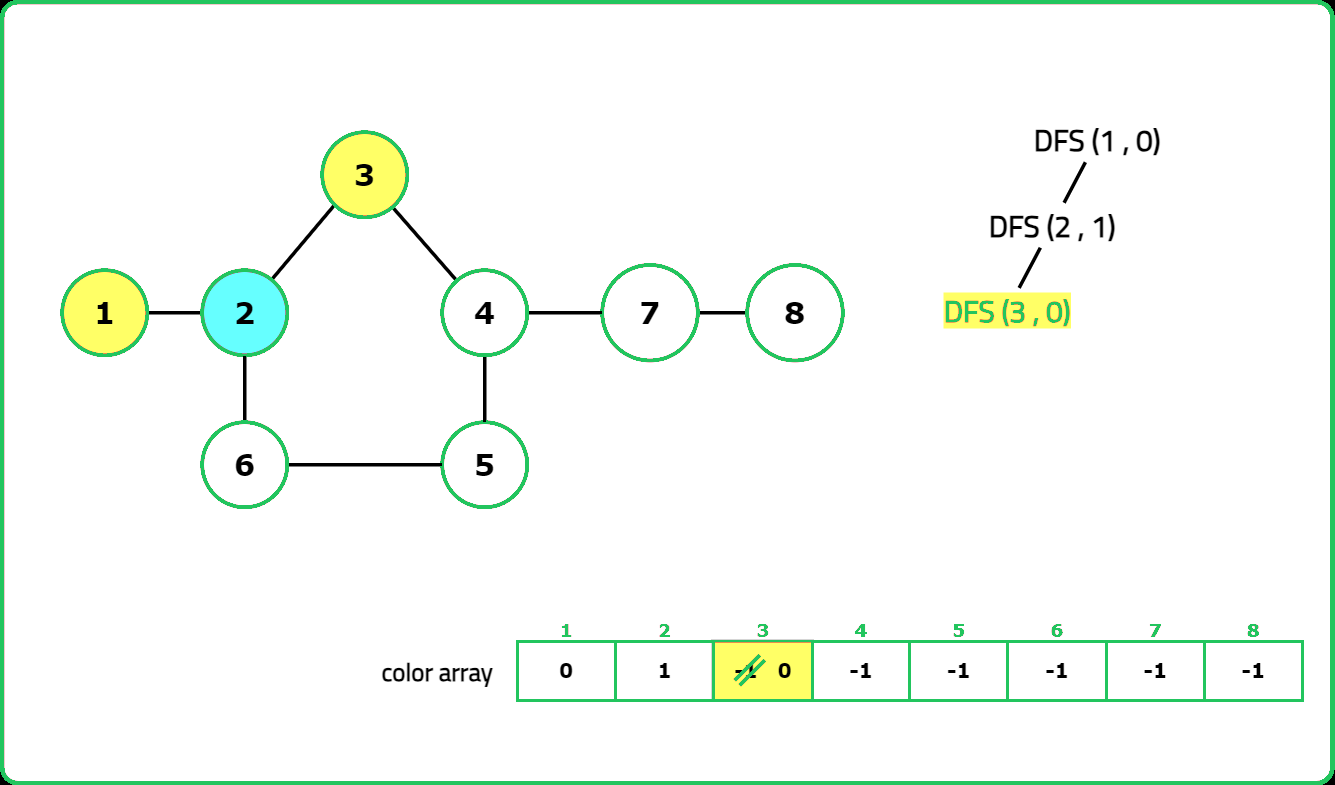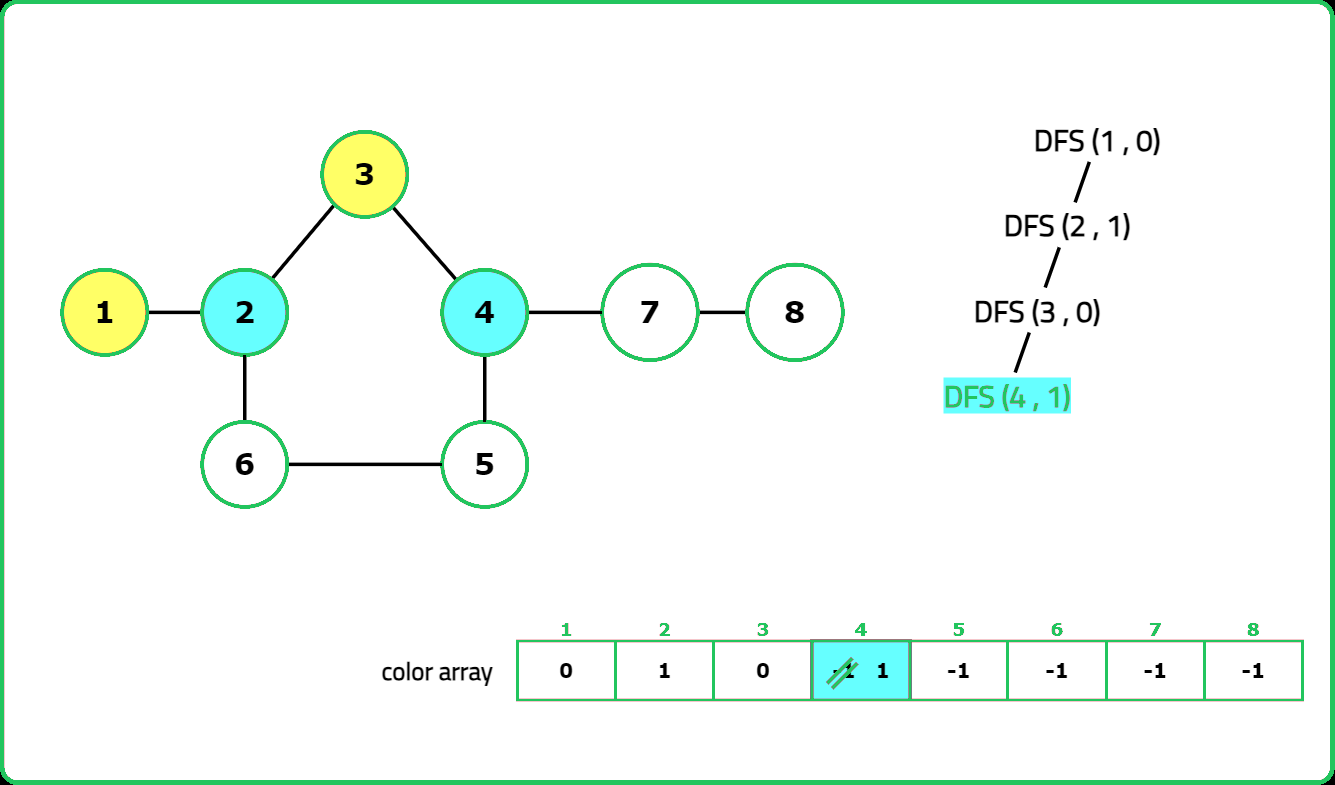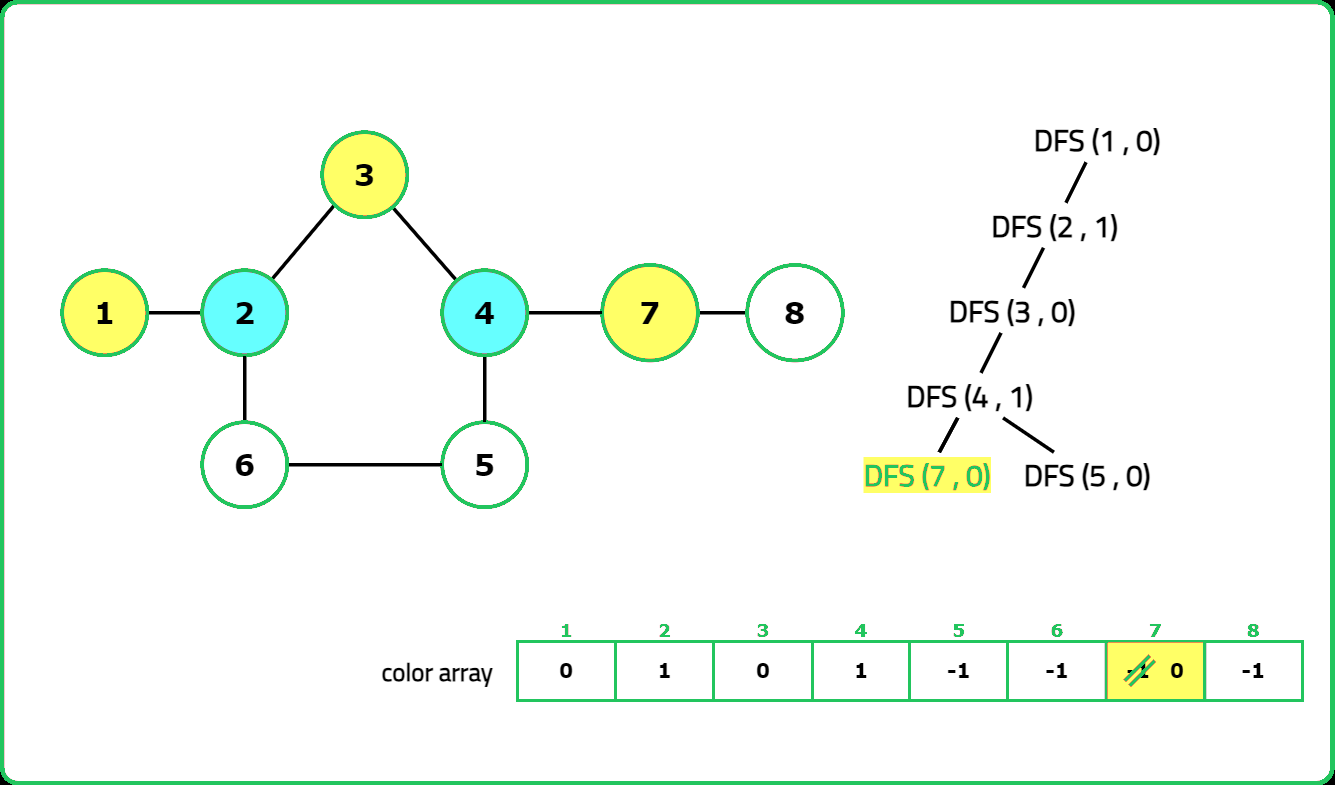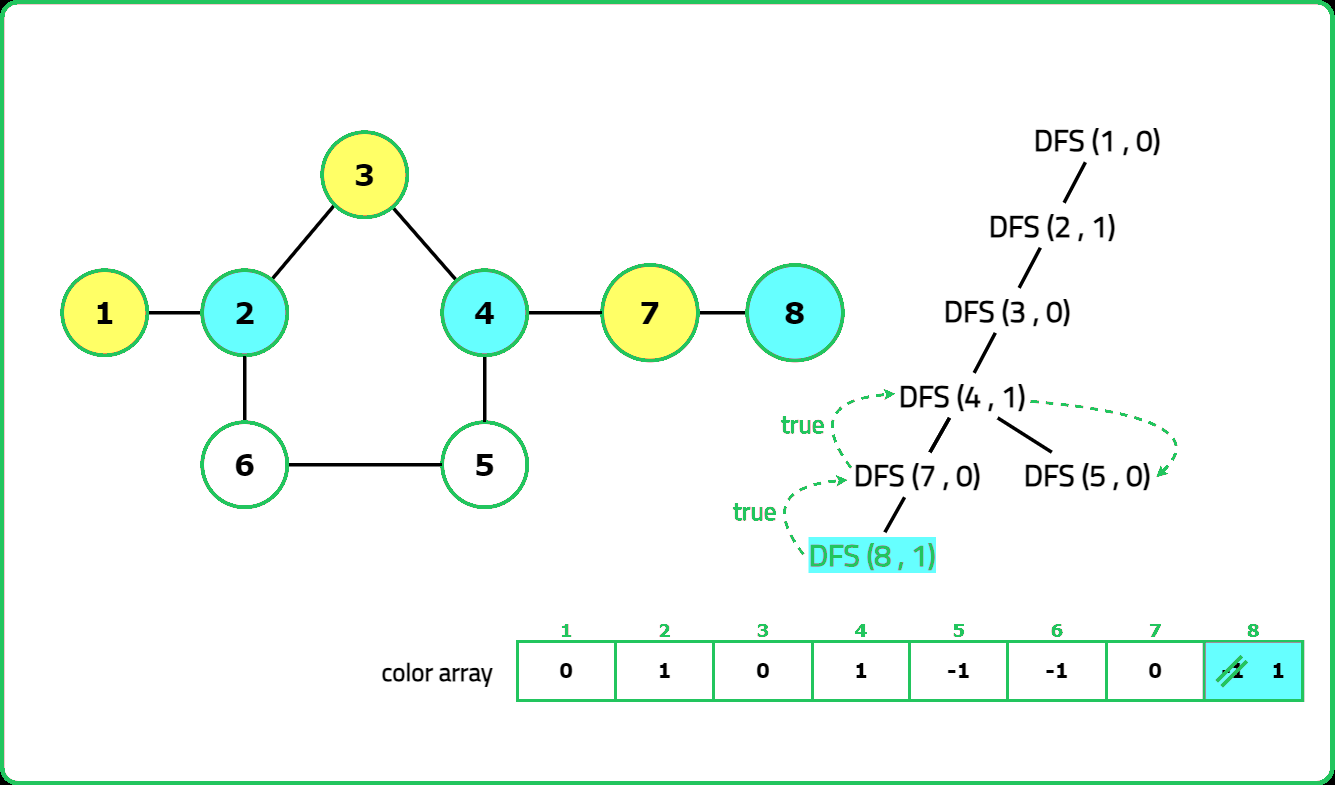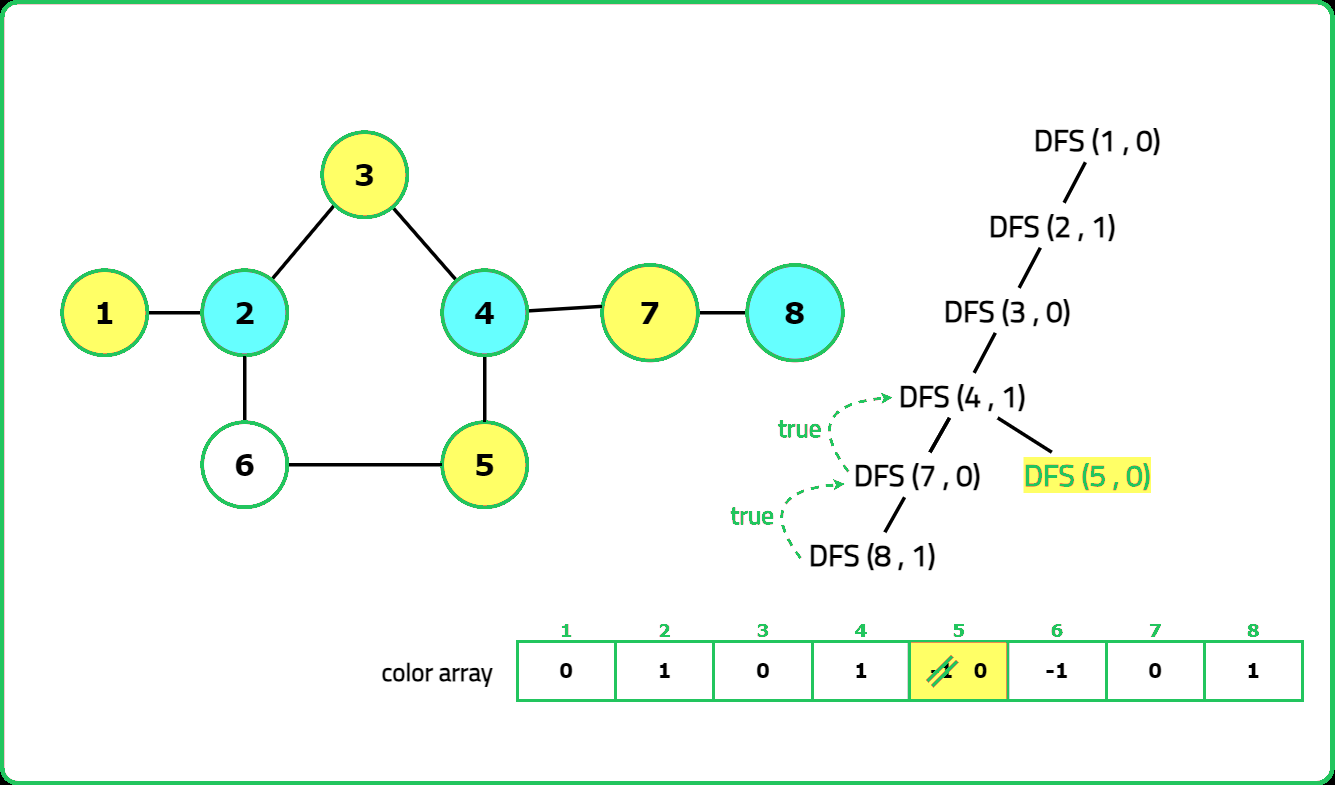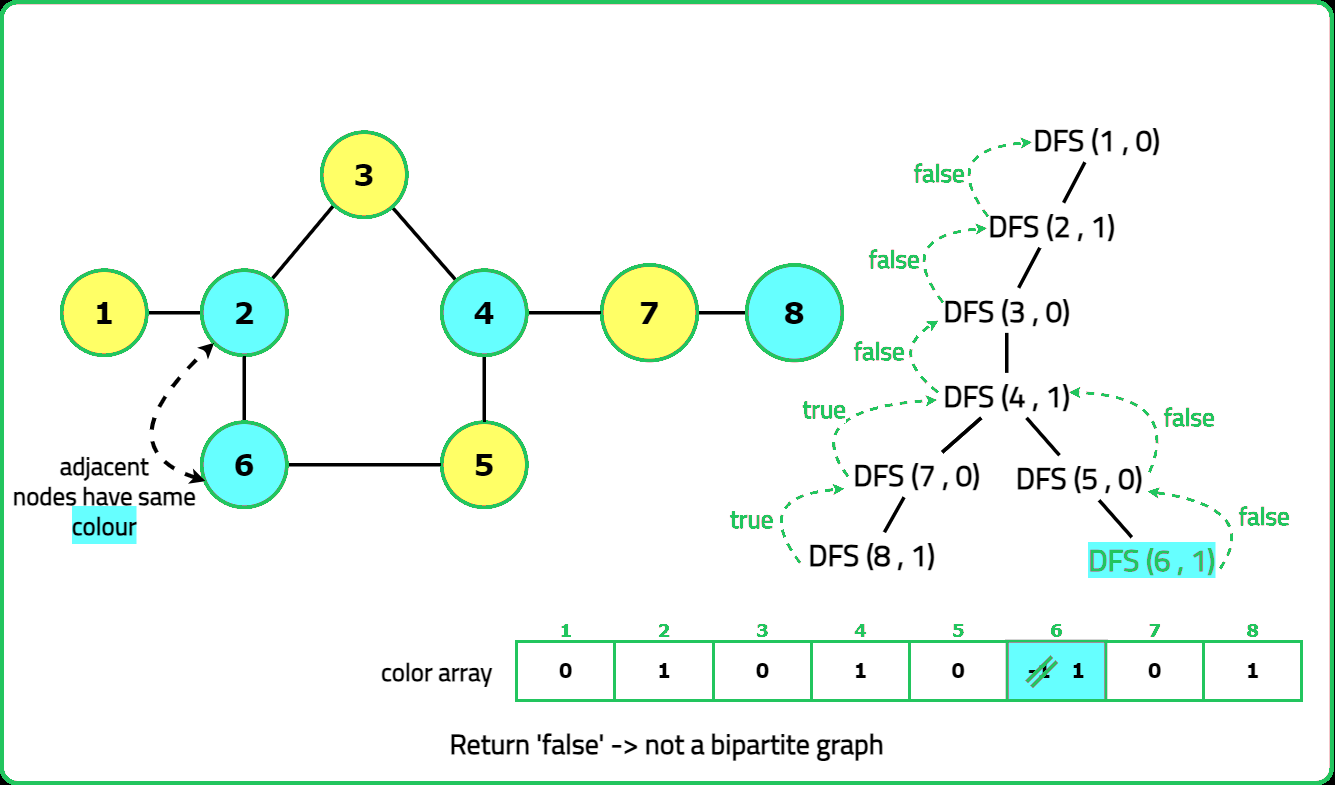12345678910111213141516171819202122232425262728293031323334353637383940414243444546474849505152535455565758596061626364656667686970717273747576777879808182838485868788899091929394959697
#include <bits/stdc++.h>
using namespace std;
class Solution {
private:
/* Function to perform DFS traversal and
color the nodes with alternate colors*/
bool dfs(int node, int col, vector<int> &color,
vector<int> adj[]) {
// Color the current node
color[node] = col;
// Traverse adjacent nodes
for(auto it : adj[node]) {
// if uncoloured
if(color[it] == -1) {
// Recursively color the nodes
if(dfs(it, !col, color, adj) == false)
return false;
}
// if previously coloured and have the same colour
else if(color[it] == col) {
// Return false as it is not bipartite
return false;
}
}
/* Return true if all the nodes can
be colored with alternate colors */
return true;
}
public:
/* Function to check if the
given graph is bipartite */
bool isBipartite(int V, vector<int> adj[]) {
/* To store the color of nodes, where
each node is uncolored initially */
vector<int> color(V, -1);
// Start Traversal of connected components
for(int i=0; i<V; i++) {
/* if a node is not colored,
a new component is found */
if(color[i] == -1) {
/* Start DFS traversal
and color each node */
if(dfs(i, 0, color, adj) == false) {
/* Return false if component
is found not to be bipartite */
return false;
}
}
}
/* Return true if each
component is bipartite */
return true;
}
};
int main() {
int V = 4;
vector<int> adj[V] = {
{1,3},
{0,2},
{1,3},
{0,2}
};
/* Creating an instance of
Solution class */
Solution sol;
/* Function call to check
if the given graph is bipartite */
bool ans = sol.isBipartite(V, adj);
// Output
if(ans)
cout << "The given graph is a bipartite graph.";
else
cout << "The given graph is not a bipartite graph.";
return 0;
}
123456789101112131415161718192021222324252627282930313233343536373839404142434445464748495051525354555657585960616263646566676869707172737475767778798081828384858687888990919293949596979899
import java.util.*;
class Solution {
/* Function to perform DFS traversal and
color the nodes with alternate colors*/
private boolean dfs(int node, int col, int[] color,
List<Integer> adj[]) {
// Color the current node
color[node] = col;
// Traverse adjacent nodes
for(int it : adj[node]) {
// if uncoloured
if(color[it] == -1) {
// Recursively color the nodes
if(dfs(it, 1 - col, color, adj) == false)
return false;
}
// if previously coloured and have the same colour
else if(color[it] == col) {
// Return false as it is not bipartite
return false;
}
}
// Return true if all the nodes can
// be colored with alternate colors
return true;
}
// Function to check if the given graph is bipartite
public boolean isBipartite(int V, List<Integer> adj[]) {
// To store the color of nodes, where
// each node is uncolored initially
int[] color = new int[V];
Arrays.fill(color, -1);
// Start Traversal of connected components
for(int i = 0; i < V; i++) {
// if a node is not colored,
// a new component is found
if(color[i] == -1) {
// Start DFS traversal
// and color each node
if(dfs(i, 0, color, adj) == false) {
// Return false if component
// is found not to be bipartite
return false;
}
}
}
// Return true if each
// component is bipartite
return true;
}
}
public class Main {
public static void main(String[] args) {
int V = 4;
List<Integer> adj[] = new ArrayList[V];
for (int i = 0; i < V; i++) {
adj[i] = new ArrayList<>();
}
adj[0].add(1);
adj[0].add(3);
adj[1].add(0);
adj[1].add(2);
adj[2].add(1);
adj[2].add(3);
adj[3].add(0);
adj[3].add(2);
// Creating an instance of Solution class
Solution sol = new Solution();
// Function call to check if the given graph is bipartite
boolean ans = sol.isBipartite(V, adj);
// Output
if(ans)
System.out.println("The given graph is a bipartite graph.");
else
System.out.println("The given graph is not a bipartite graph.");
}
}
123456789101112131415161718192021222324252627282930313233343536373839404142434445464748495051525354555657585960616263646566676869707172737475
class Solution:
# Function to perform DFS traversal and
# color the nodes with alternate colors
def dfs(self, node, col, color, adj):
# Color the current node
color[node] = col
# Traverse adjacent nodes
for it in adj[node]:
# if uncoloured
if color[it] == -1:
# Recursively color the nodes
if not self.dfs(it, 1 - col, color, adj):
return False
# if previously coloured and have the same colour
elif color[it] == col:
# Return false as it is not bipartite
return False
# Return true if all the nodes can
# be colored with alternate colors
return True
# Function to check if the given graph is bipartite
def isBipartite(self, V, adj):
# To store the color of nodes, where
# each node is uncolored initially
color = [-1] * V
# Start Traversal of connected components
for i in range(V):
# if a node is not colored,
# a new component is found
if color[i] == -1:
# Start DFS traversal
# and color each node
if not self.dfs(i, 0, color, adj):
# Return false if component
# is found not to be bipartite
return False
# Return true if each
# component is bipartite
return True
if __name__ == "__main__":
V = 4
adj = [[] for _ in range(V)]
adj[0].extend([1, 3])
adj[1].extend([0, 2])
adj[2].extend([1, 3])
adj[3].extend([0, 2])
# Creating an instance of Solution class
sol = Solution()
# Function call to check if the given graph is bipartite
ans = sol.isBipartite(V, adj)
# Output
if ans:
print("The given graph is a bipartite graph.")
else:
print("The given graph is not a bipartite graph.")
123456789101112131415161718192021222324252627282930313233343536373839404142434445464748495051525354555657585960616263646566676869707172737475767778
class Solution {
/* Function to perform DFS traversal and
color the nodes with alternate colors*/
dfs(node, col, color, adj) {
// Color the current node
color[node] = col;
// Traverse adjacent nodes
for (let it of adj[node]) {
// if uncoloured
if (color[it] === -1) {
// Recursively color the nodes
if (!this.dfs(it, 1 - col, color, adj))
return false;
}
// if previously coloured and have the same colour
else if (color[it] === col) {
// Return false as it is not bipartite
return false;
}
}
// Return true if all the nodes can
// be colored with alternate colors
return true;
}
/* Function to check if the
given graph is bipartite */
isBipartite(V, adj) {
// To store the color of nodes, where
// each node is uncolored initially
let color = new Array(V).fill(-1);
// Start Traversal of connected components
for (let i = 0; i < V; i++) {
// if a node is not colored,
// a new component is found
if (color[i] === -1) {
// Start DFS traversal
// and color each node
if (!this.dfs(i, 0, color, adj)) {
// Return false if component
// is found not to be bipartite
return false;
}
}
}
// Return true if each
// component is bipartite
return true;
}
}
const main = () => {
const V = 4;
const adj = [
[1, 3],
[0, 2],
[1, 3],
[0, 2]
];
// Creating an instance of Solution class
const sol = new Solution();
// Function call to check if the given graph is bipartite
const ans = sol.isBipartite(V, adj);
// Output
if (ans)
console.log("The given graph is a bipartite graph.");
else
console.log("The given graph is not a bipartite graph.");
}
main();
